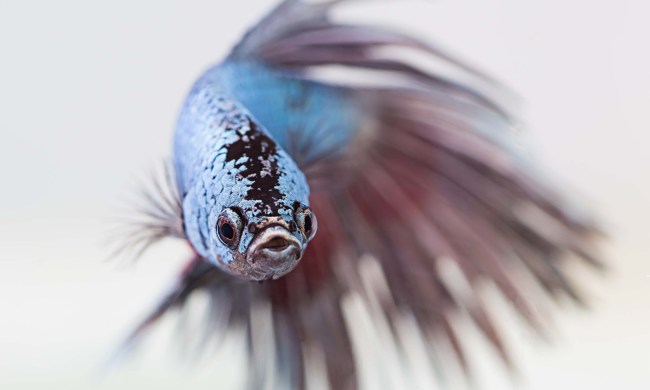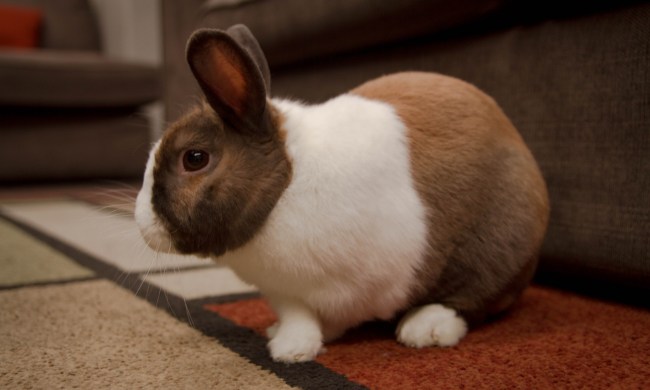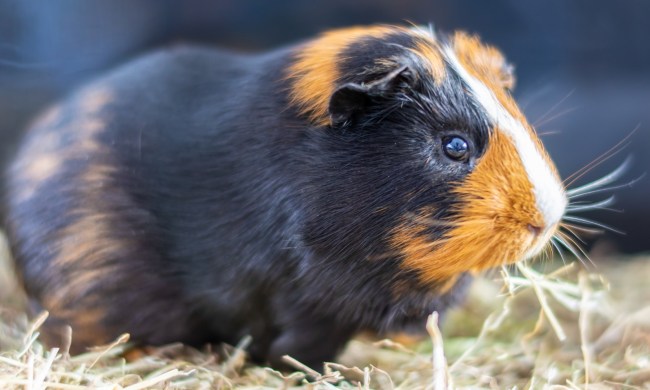While we may all wish to see ourselves through our pets eyes, that curiosity can come with some questions. When it comes to your bunny, you may wonder if they know what color their favorite bed is, or if they can see the fall leaves or the spring flowers outside. But can rabbits see color? The short answer is that, although rabbits have a limited range of color vision, they are not completely color blind.

Bunny vision
Rabbits are prey animals. To help them avoid becoming someone else’s dinner, their large, protruding eyes allow them to see at an almost 360-degree range. They are also farsighted: They can see things far away better than they can see things close to them. Additionally, they do not have good depth perception because their lines of sight do not overlap. Humans have excellent depth perception because our eyes face the same direction, and our lines of sight overlap significantly.
A bunny might miss a treat lying on the floor but will react dramatically to movement far away. This reaction is for rabbits’ protection in the wild and is an excellent example of how they use sight in their day-to-day lives. These attributes allow them to see predators coming and give them time to escape, although rabbits do not see well in bright light or complete darkness. Rabbits see best at dusk and dawn, when predators are hunting and wild rabbits are most active.
Color blind vs. color limited
Humans can be color blind, but not all color blindness is the same. The part of the eye that interprets color is the cells known as cones and rods. Rods work in the low levels of light range, and cones read high-light situations. Cones are also responsible for the majority of color vision and spatial acuity. Spatial acuity means being able to see the contrast in colors and shades.
Cones and rods come in a variety of ratios depending on species and genetics. In humans, defects within the eye causing rod and cone ratios to be off can cause someone to see either limited colors or more colors than the average human sees. As humans, we have three varieties of cones for different color ranges. The variety ratios will determine whether we experience some color blindness.
Bunnies have a higher ratio of rods to cones. Because rabbits have a limited number of cones, their color vision is called dichromate, which means they mainly see two colors, green and blue.
What does this mean for bunnies?
Now that we have the science out of the way, what does all this mean for your pet rabbit, and what can you do to make life easier for your limited-color-vision friend? Not only should you consider how their limited color vision affects their life, but it’s also important to remember how a rabbit sees the world. Things that may seem harmless to you could be terrifying for your bunny.
Safe space
Because rabbits are prey animals, their natural skittish tendencies keep them alive in the wild. It’s crucial to ensure your rabbit has a place to go to feel safe. They’ll appreciate having a place to go where they can feel safe and calm themselves down if they feel threatened. Be sure to provide them with a hutch, a cage, or a cubbyhole of some sort that they can access no matter where they are.
Calm movements
To keep from scaring your rabbit, avoid quick or aggressive movements around them. Such actions frighten them, and they’ll try to get away. Slow and gentle motions are the best way to make your rabbit feel safe and calm around you.
Avoid bright or dark situations
On bright, sunny days or dark nights, avoid taking your rabbit outside. Their inability to see will make them more uncomfortable and fearful.
Greens and blues
With their color range limited to blues and greens, try giving them toys and rabbit furniture in these colors. Foods such as blueberries can be a great way to help your rabbit see when you’re giving them a treat. You might even consider wearing blue and green clothing to help your bunny distinguish between you and a predator.
Although bunnies are not color blind, their limited color vision and mostly monocular vision are important to keep in mind when taking care of them. Remembering the way your bunny sees color and perceives quick movements will help make your time together more enjoyable for you both.
Want more bunny-related content? Learn how to housetrain your rabbit with a few easy steps.


